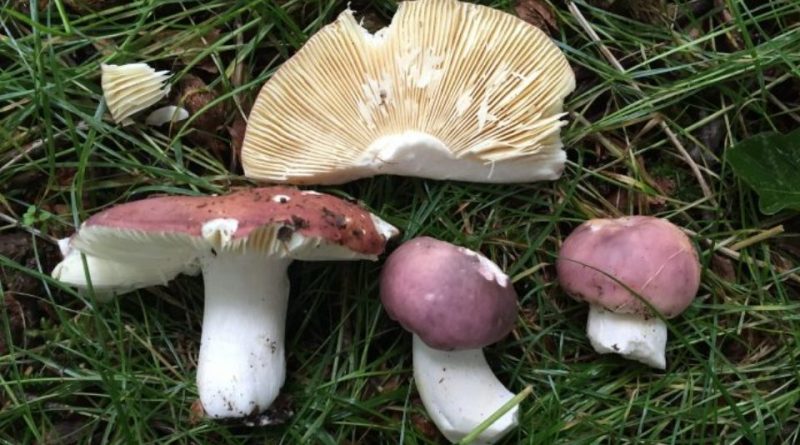Russula cyanoxantha
Russula cyanoxantha
The Russula major (Russula cyanoxantha (Schaeff.) Fr., 1863) is a basidiomycete fungus belonging to the Russulaceae family.
Systematics –
From the systematic point of view it belongs to the Eukaryota Domain, Fungi Kingdom, Phylum Basidiomycota, Class Basidiomycetes, Russulales Order, Russulaceae Family and therefore to the Genus Russula and to the R. cyanoxantha Species.
Are obsolete synonyms: Agaricus cyanoxanthus Schaeff. and Russula cutifracta Cooke.
Etymology –
The term Russula is the diminutive of red rússa: red. The specific cyanoxantha epithet comes from the Greek κυανός cyanós, turchino and ξανϑóς xanthós, yellow.
Geographical Distribution and Habitat –
It is a symbiotic mushroom, very common, which fructifies isolated or in groups, in any type of wood, both under broad-leaved and coniferous; it is found above all in calcareous soils. The fruiting period is between May and late autumn.

Recognition –
The Russula cyanoxantha is recognized for having the hat of 4–15 cm in diameter, of fleshy and hard consistency, then tender, globular, convex, finally flattened, sometimes it can be a little depressed in the center or funnel-shaped.
The cuticle is partly separable moist, glossy, brilliant, then dry but always oily, wrinkled, rarely chapped, iridescent, with a metallic appearance, extremely variable in color, commonly of a violet-blue, lilac-pink color, with some yellowish discoloration, gray-green, brown-olive. It has a thin margin, first convoluted, then dull regular, smooth.
The gills are dense, thick, free at the stem, of firm consistency and lardaceous to the touch, with scarce lamellulas, white then whitish or slightly bluish, brown-stained in old age, especially on the wire, elastic, bending, but not shattering .The stem measures 4-12 x 1.6–5 cm; it is fleshy, firm, full, then spongy, cylindrical or half-swollen, dry, pruinose, then wrinkled, white or with slight violet nuances with brown spots in old age.
The flesh is thick, firm, compact and consistent, then spongy, sometimes white with brownish spots, with purple hues under the cuticle, greyish on drying or after prolonged exposure to air; it has a faint, pleasant and fungal odor and a very pleasant, sweet and nutty flavor.
At the microscope we can see white spores in mass, elliptic, with large warts, 7-10 x 5-6.5 µm. The cystidia are fusiform.
Cultivation –
Russula cyanoxantha is not a cultivated mushroom.
Uses and Traditions –
The Russula cyanoxantha is one of the most common mushrooms of its kind as it grows in abundance for a rather extended period that runs from May to late autumn. Moreover being in every type of wood and being of pleasant taste and good consistency it is a mushroom very known and appreciated by collectors. , with that feeling of greasiness that transmits to the touch and for the scarce shatterability of the same to the rubbing with the fingers.
From the edible point of view it is an excellent mushroom and is, in fact, among the most appreciated Russulas.
Preparation Mode –
As and even more so for the other edible Russulas, Russula cyanoxantha is a very versatile mushroom in the kitchen. This mushroom can be eaten raw in vegetable salads d is excellent sautéed with garlic, extra virgin olive oil and parsley.
Some recipes include preparing these stuffed Russulas choosing the largest and most regular hats to fill with a dough made with ground beef or cheese, lots of flavorings and chopped stems, because nothing is thrown away of this mushroom.
Other recipes are those for pasta sauces, especially the linguine mare e monti with Russule. This Russula can be cooked in the form of a cutlet: in this case, after having deprived them of the stem, fry them to flavor and then pass them in the breadcrumbs and fry in the oven. Or bread with the egg and fry in plenty of oil. For an unusual appetizer you can cook these Russules and then blend them and reduce them to a cream to lay on slices of toasted bread and with melted cheese.
Guido Bissanti
Sources
– Wikipedia, the free encyclopedia.– Cetto B., 2008. The mushrooms from life, Saturnia, Trento.– Pignatti S., 1982. Flora of Italy, Edagricole, Bologna.– Conti F., Abbate G., Alessandrini A., Blasi C. (ed.), 2005. An annotated checklist of the Italian vascular flora, Palombi Editore.
Attention: Pharmaceutical applications and food uses are indicated for informational purposes only, do not in any way represent a medical prescription; therefore no responsibility is assumed for their use for curative, aesthetic or food purposes.

